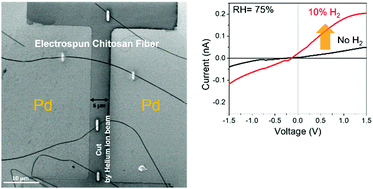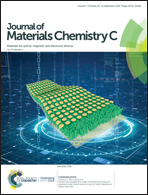Enhanced protonic conductivity and IFET behavior in individual proton-doped electrospun chitosan fibers†
Abstract
A major challenge for biomedical science is developing materials and processing methods to enable creation of devices that can meaningfully translate signals between biology and electronics. Protonics-based devices—devices analogous to electronic devices but which use protons as charge carriers instead of electrons—are a promising strategy for such translation. Proton-conductive materials (PCMs)—the media through which protons are transported in such devices—are an element ripe for improvement, since they dominate the performance of protonic devices. We investigate protonic devices comprising sub-micrometer diameter, chitosan-fiber PCMs and palladium hydride (PdHx) protodes, the proton-injecting contact, to analyze how proton transport depends on the chemistry and ordering of the PCM. Current–voltage (I–V) measurements of single fiber-based devices under hydrogen atmospheres show that fibers electrospun from trifluoroacetic acid (TFA) solutions feature substantially higher proton conductivity, up to two orders of magnitude, compared to chitosan PCM films cast from acetic acid solutions. We further used digital simulation of the I–V data to elucidate the electrochemical and electrical processes that control device operation. The hydrogen oxidation reaction kinetics of the protode interfaces with the electrospun chitosan fibers agree well with those reported previously. Using X-ray photoelectron spectroscopy (XPS), we observed that single chitosan fibers spun from TFA solutions are more highly proton-doped than chitosan cast from acetic acid. Furthermore, I–V measurements on electrospun chitosan fibers vs. spin-cast chitosan films, both derived from TFA solutions, reveal that electrospun chitosan fibers yield ∼10-fold higher proton conductivity, suggesting that local polymer ordering within the electrospun fibers further enhances proton transport for chitosan PCMs. Finally, devices fabricated from single doped chitosan fibers behave as ionic field effect transistors (IFETs) when under a contact gate bias established with a conducting probe AFM tip. Switching characteristics are tuned by the gate bias, with proton conduction of a single fiber increasing by over an order of magnitude under negative bias. The switchable ion currents and enhanced conductivity of the chitosan fiber-based PCMs comprise a means of establishing spatiotemporal control over ionic communication between protonic devices and adjacent biological cells and membranes.

- This article is part of the themed collection: 2019 Journal of Materials Chemistry C HOT Papers


 Please wait while we load your content...
Please wait while we load your content...
